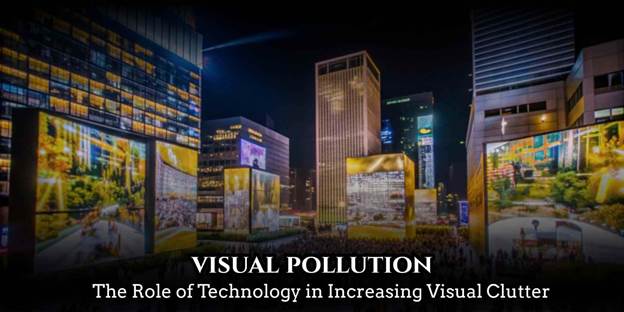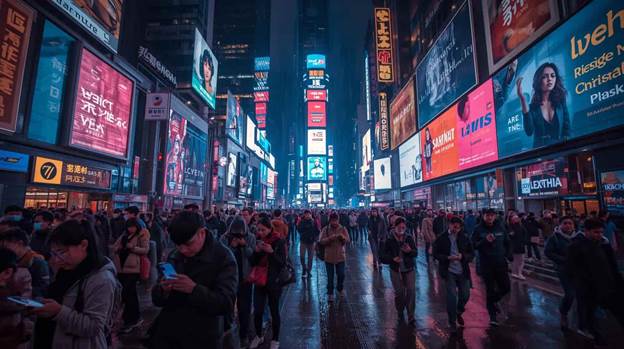Understanding Visual Pollution in the Digital Age
Visual pollution refers to the excessive presence of unwanted or disruptive visual elements in our surroundings. In today’s world, the rise of technology has intensified this problem, filling cities and digital spaces with overwhelming signs, screens, and advertisements. As the visual environment becomes increasingly saturated, the quality of human perception, attention, and mental peace declines.
Table of Contents
This article explores how modern technology contributes to visual clutter, the consequences of such pollution, and how sustainable design solutions can help restore aesthetic balance.

Defining Visual Pollution and Its Technological Origins
Visual pollution can be defined as any visual element that disrupts the natural or built environment, causing distraction, discomfort, or stress. With the introduction of digital media, this issue has expanded from physical spaces to virtual ones.
In urban landscapes, billboards, neon lights, and digital signage compete for attention, while in digital ecosystems, pop-up ads, notifications, and cluttered interfaces contribute to sensory overload.
Key technological sources of visual pollution include:
- Large digital billboards and LED displays
- Excessive social media advertising
- Poorly designed websites and mobile apps
- Overuse of bright lights in public and private spaces
The rapid integration of visual technology has blurred the line between aesthetic innovation and sensory invasion.
The Digital Transformation of Urban Spaces
Technology has reshaped cityscapes through the introduction of smart infrastructure and digital communication. While these innovations enhance efficiency, they also generate visual clutter when applied without regulation.
For example, Times Square in New York and Shibuya Crossing in Tokyo are global symbols of digital brilliance but also examples of visual saturation. The constant flashing of screens and advertisements makes it difficult for the human eye to rest, reducing visual comfort.
Moreover, technological competition among brands leads to oversized and brightly lit signage, increasing light pollution and energy consumption.
How Visual Clutter Impacts Human Behavior
Visual pollution doesn’t just affect aesthetics it influences cognitive and emotional well-being. Research in environmental psychology indicates that constant exposure to cluttered visuals increases mental fatigue, stress, and reduced focus.
Negative effects of visual clutter include:
- Increased anxiety and distraction
- Difficulty in processing information
- Reduced productivity and creativity
- Visual fatigue and eye strain
In digital contexts, excessive pop-ups, auto-playing videos, and banner ads disrupt user attention and reduce engagement. The same problem appears in physical spaces, where chaotic advertising distracts drivers, pedestrians, and consumers.
The Role of Digital Advertising in Visual Overload
The explosion of digital marketing has dramatically increased visual clutter both online and offline. Companies compete for visibility through multiple channels social media, websites, outdoor displays, and mobile notifications.
While advertising drives economic growth, unregulated visual messaging has created “attention pollution.” Users are bombarded with thousands of stimuli daily, leaving little room for conscious visual rest.
Examples of tech-driven visual pollution:
- Scrolling through social media feeds filled with sponsored posts
- Smart city screens displaying nonstop commercial content
- Augmented reality ads that overlap with real-world views
This continuous bombardment of visual stimuli fragments focus and diminishes the quality of visual experiences.
Technology and the Rise of Digital Visual Pollution
Beyond physical clutter, visual pollution has taken over digital environments through poorly designed interfaces and content overload. Websites filled with animations, blinking banners, and autoplay videos contribute to digital noise.
Mobile devices, once meant to simplify communication, now create constant visual stimulation through app notifications and icons.
Common forms of digital visual clutter:
- Overloaded user interfaces (UIs)
- Excessive animation or transitions
- Overuse of color and contrast
- Non-stop push notifications
As people spend more time in front of screens, digital visual pollution becomes a subtle yet pervasive mental health challenge.

Sustainable and Aesthetic Solutions to Reduce Visual Clutter
To combat visual pollution, both designers and policymakers must embrace aesthetic minimalism and technological responsibility. Sustainable visual design can help create harmony between human needs and digital innovation.
Strategies to reduce visual clutter:
- Implement stricter regulations on digital advertising in public spaces
- Encourage minimalist and eco-friendly design principles
- Promote green walls, public art, and natural color schemes in cities
- Use user-centered design to declutter digital interfaces
- Apply dark mode and adaptive lighting to reduce glare
Tech companies can also integrate AI-based optimization tools to minimize unnecessary notifications and advertisements. This not only enhances user satisfaction but also contributes to a cleaner visual ecosystem.
Global Initiatives Addressing Visual Pollution
Several countries have started taking action against visual pollution.
- France limits illuminated signs and digital billboards to conserve energy and maintain aesthetic quality.
- South Korea enforces restrictions on street advertising to preserve cultural heritage zones.
- Singapore integrates green urban planning to balance digital signage with natural landscapes.
These efforts show that visual harmony can coexist with technological progress when guided by conscious regulation and design ethics.
The Future of Visual Environments
As technology continues to evolve, balancing innovation with environmental psychology will be essential. The challenge lies in developing smart, visually sustainable environments that stimulate creativity without overwhelming the senses.
Future cities may use adaptive digital systems that adjust lighting and advertising based on human comfort levels. Ethical design, data-driven policies, and public awareness can collectively reduce the burden of visual clutter.
Conclusion
Visual pollution has become one of the most overlooked consequences of technological advancement. While digital innovation enhances convenience and communication, it also fills our surroundings with unnecessary visual noise. By promoting minimalist design, responsible advertising, and thoughtful regulation, societies can reclaim aesthetic balance in both physical and digital spaces. Embracing simplicity in visual culture will not only beautify our environment but also restore mental clarity and well-being.